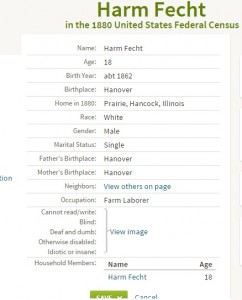 The “view record” page for Harm Fecht on Ancestry.com indicates that he is the only individual living in his household in 1880. It’s easy to see at the very bottom of the image included with this post. When I encountered the record while looking for someone else, I thought it looked strange as I was fairly familiar with the Fechts of Hancock County, Illinois’ Prairie Township and I did not remember a Harm living alone as an 18 year old.
The “view record” page for Harm Fecht on Ancestry.com indicates that he is the only individual living in his household in 1880. It’s easy to see at the very bottom of the image included with this post. When I encountered the record while looking for someone else, I thought it looked strange as I was fairly familiar with the Fechts of Hancock County, Illinois’ Prairie Township and I did not remember a Harm living alone as an 18 year old.
That’s because he didn’t.
The actual census image for Harm indicated he was living in the household of Jacob Fecht as a hired man. But yet his “record” on Ancestry.com indicated he was alone in his household.
I decided to search for an ancestor that I knew was living as a boarder with relatives in 1880, just to see. Sure enough Voke Goldenstien (actually Focke Goldenstein) is shown in his record entry as being the only individual in the household.
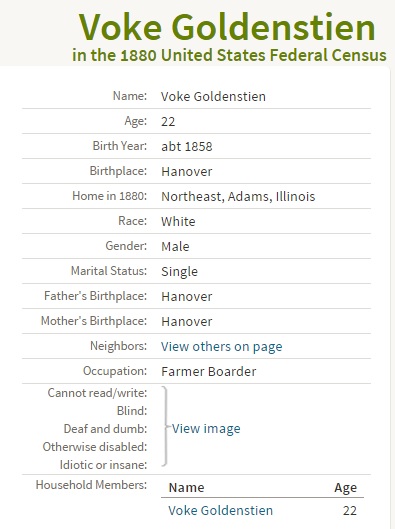
Sure enough when one views the census image, he is listed as a boarder in the household of Eme Aden. Why those household names are not showing up with him I am not certain.
I decided to search for a family that I knew had servants in 1880, just to see. Sure enough the “record” screen for Michael Trautvetter showed his wife and children as living in his household. According to this screen only Trautvetters (Dratvetter according to the census enumeration) lived in the household. I knew that was not right as I’d seen the entry before and distinctly remembered Trautvetter having hired help.
Sure enough he did. There are clearly two additional individuals living in the household: Friederich Richmeier and John [something or other]. Why those two names are not showing up on the other screen I am not certain. 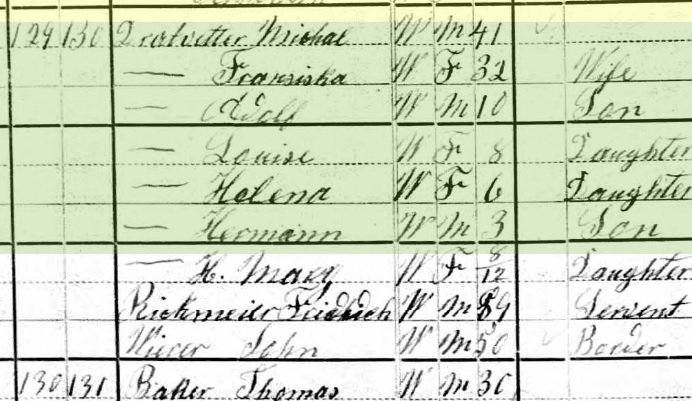
All screen shots were taken on 19 February 2016.
I have not had time to see how this impacts the searching or if other census years that included relationships to head of household are also done in this fashion (remember 1880 is the first census year to show relationships). But I wish the households weren’t stripped of the boarders the way Ancestry.com has chosen to remove them from the household.

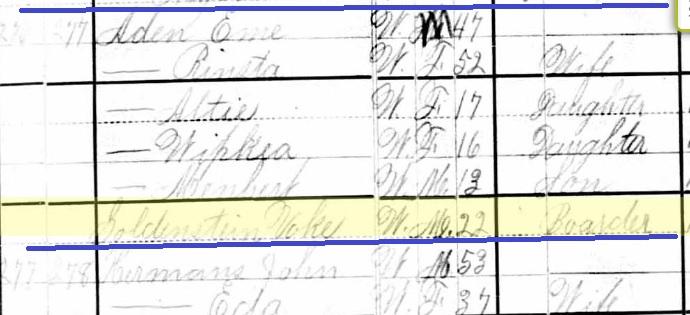
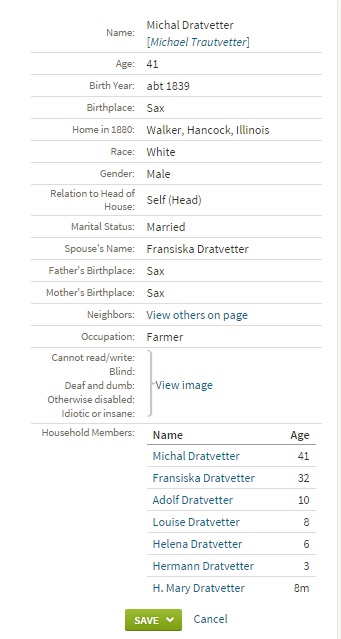

9 Responses
They are not consistent with it, since my husband and I have seen boarders/servants/hired help listed on Ancestry records for our respective families (and listed in the same order as on the original document to boot). I’m afraid I can’t pull any examples to show, since I usually look/download the original document to my computer and don’t bother with the record after that. I search mostly in Milwaukee, Racine, and Ozaukee Counties, WI, and Cook Co, IL; my husband is mostly around the Alton, IL area and St Louis Co, MO. I don’t know if that makes a difference or not.
They must be inconsistent with this. I checked an ancestor, Elizabeth Kolker, in Quincy, IL in 1900 because I knew she had boarders. And they are listed. I don’t know how Ancestry handles this process, but I wonder if some transcriber just decided to leave off names that weren’t the same as the head of household. I would hope that is not the case because there can be some good clues among those boarders!
I’m more inclined to think it’s the transcriber. I can’t remember which census it was where everyone on the page is listed as one entry. And another that somehow combined two families making my great grandmother married to someone I was never able to track and making the man a bigamist. I’ve corrected those census at ancestry numerous times but so far they are still wrong. I’ve made lots of transcription corrections at ancestry but no one every fixes them.
I’ve also found the same thing with a family (same last name for all family members) on 2 pages; husband (on first page) listed alone, and wife and children (on next page) listed as a separate family on the next page.
It would seem that sometimes /Ancestry.com will list boarders and then other times they are not listed as being in the household at all. I have found this true with listings as late as 1890 and 1900 in Virginia in my own family name files. I even found that my father, married to my mother is listed under a separate
listing in the 1940 census in Norfolk, Virginia although they are married and living together in her Mothers home. Strange how some information is deleted or moved or just not filed correctly in the records.
The only common element between the original census doc and the Ancestry listing is the transcriber. In the many transcribers they hire, some will be good, some bad and the rest will fall somewhere in between. We’ve all learned that you always need to verify by looking at the original.
I agree with those who think it is the common element of the transcriber. It is so important that I do wish Ancestry would adopt better rules for transcription. It seems to be written in stone once they have had their say. It is sometimes so difficult for the researcher to stay awake browsing through dozens and hundreds of entries, but to enter a name and come up with hundreds of thousands, knowing that so many of them are wacky entries is just overwhelming and I often just give up. better training is called for.
I would put some blame on the transcriber. My understanding is Ancestry has one person transcribe the record. Having done transcribing for Family Search, I feel more confident in their method. Every record has two people transcribe the Census record, if the two disagree an arbitrator then looks at the record to see which is “correct”. I also did some arbitration and there were a few times I didn’t agree with either transcription. Since this is done by human being we all make mistakes even in the best of circumstances.
Ancestry doesn’t offer much to help with “relationships” that were listed as boarders. They don’t even mention categories such as orphans or surrenders. But lots of children fell into these categories, especially prior to the 20th century. But many of the families were very important in the life of the ancestor. It would be nice if there were a “broken line” or some other way to include important people in the history of your family.